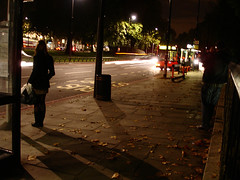Are some women foregoing transit because of fear?

Posted February 23, 2010 at 1:29PM
Anastasia Loukaitou-Sideris of the UCLA urban planning faculty has recently released research findings suggesting that women feel particularly vulnerable for their safety in transit-related environments.  In How to Ease Women’s Fear of Transportation Environments: Case Studies and Best Practices (Mineta Transportation Institute Report 90-01, October 2009), Loukaitou-Sideris and her research partners conclude:
In How to Ease Women’s Fear of Transportation Environments: Case Studies and Best Practices (Mineta Transportation Institute Report 90-01, October 2009), Loukaitou-Sideris and her research partners conclude:
“In general, women register much higher levels of fear of victimization in public and transit settings than men, which clearly affects their travel patterns and modal choices, and often makes them prefer—if they can afford it—the security of the private automobile over the unpredictability of public transportation.”
Two more specific findings from the research ring particularly intuitive. First, women do not feel safer as a result of security cameras. Second, women feel particularly vulnerable in the more open and public environments of bus stops and parking lots than inside transit vehicles and enclosed transit stations; yet most transit operators’ security efforts concentrate on the latter.
 Loukaitou-Sideris describes efforts of transit operators in other countries (the UK, Mexico, Canada, Japan and Australia, for example) to assess and respond to the needs of women passengers through specific programs, but find that such initiatives are lacking in the US:
Loukaitou-Sideris describes efforts of transit operators in other countries (the UK, Mexico, Canada, Japan and Australia, for example) to assess and respond to the needs of women passengers through specific programs, but find that such initiatives are lacking in the US:
“Our survey revealed a general ambiguity among transit operators regarding the security needs and the appropriate security measures for female passengers, and an almost complete lack of implemented programs in the US. This finding points to a major gap between research and practice, and a mismatch between the needs of women and the practices of transit operators in the US.”
I have long thought that transit advocates’ near-exclusive emphases on adding transit capacity while making travel more costly and inconvenient for drivers, but neglecting the quality of the transit experience, was misplaced. But what to do, especially in an era when transit infrastructure is crumbling and providers are having to cut back service to balance budgets?
Loukaitou-Sideris has a set of recommendations that, unsurprisingly, includes incorporating women’s voices more specifically into planning and decision-making.  She and her research colleagues also recommend a “whole journey approach” to safety that addresses the environment around transit facilities as well as the facilities themselves. In an interview with Tim Halbur on Planetizen, Loukaitou-Sideris added:
She and her research colleagues also recommend a “whole journey approach” to safety that addresses the environment around transit facilities as well as the facilities themselves. In an interview with Tim Halbur on Planetizen, Loukaitou-Sideris added:
“For example, you have a station platform that is well lit and there are a lot of people around. But if you have to park at the park-and-ride lot and walk to the platform, the walk may be dark. Oftentimes, women are scared of parking lots. So they range from locational issues and design issues to policy issues like having dedicated spaces for women drivers nearby security kiosks. Some other countries have ‘request stop’ programs at night, where women can ask the bus driver to stop where it is safer for them instead of just at the designated bus stop . . .
“There are studies in Chicago that find block-by-block that more crime tends to happen in the vicinity of the station than within the station, and my own studies show the same. And that's something more transit agencies need to look at. It's admittedly more difficult to implement, it's easier to protect the enclosed vehicle or the enclosed station. But there are so many components to today's transit stations, like park-and-ride lots, escalators, elevators. They really need to look at all of these components and how they link to the rest of the city, because a lot of the crime happens in these in-between spaces.”